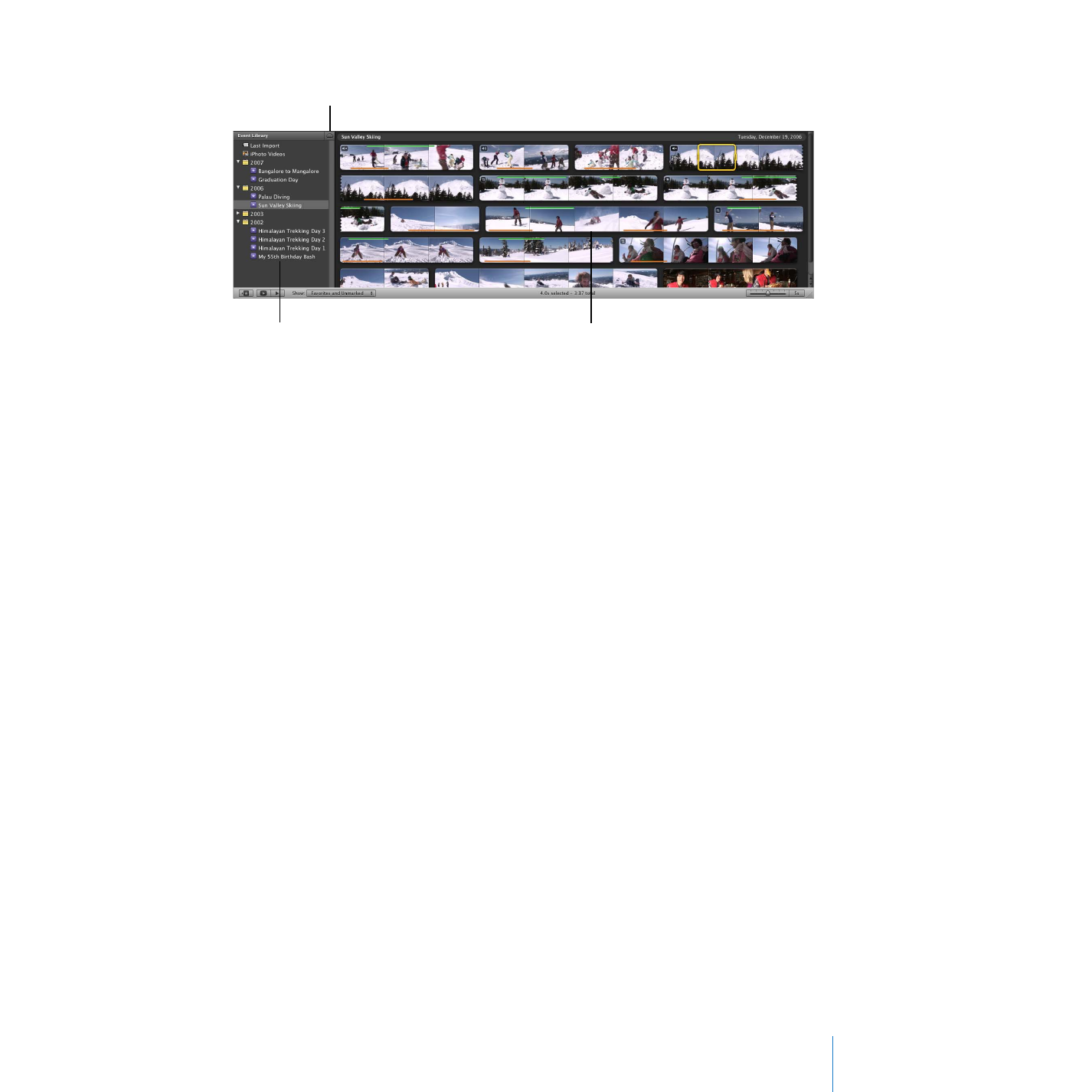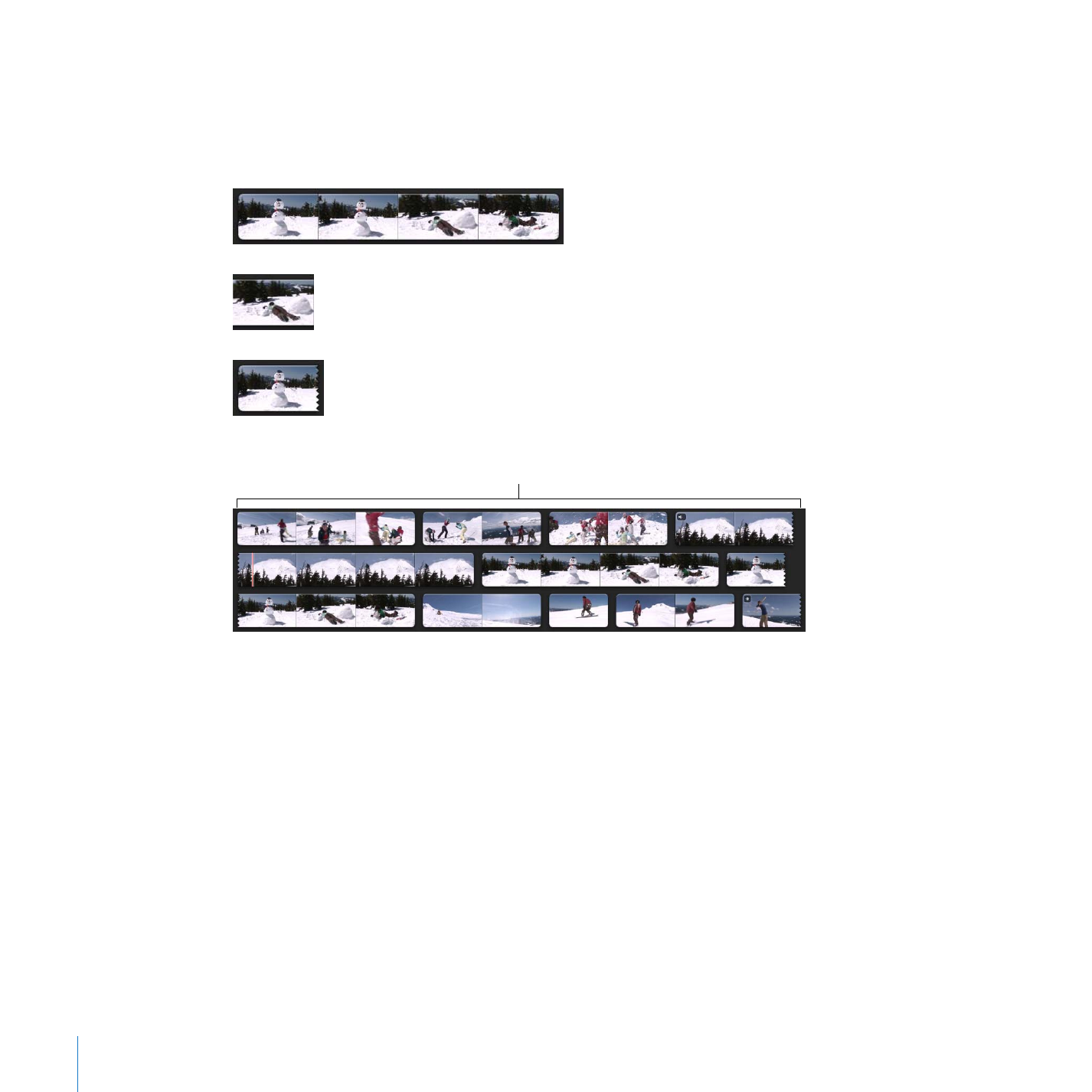
Viewing Your Source Video
Select the name of any Event you’ve created in the Event Library and take a look at the
video segments it contains. The video contained in your Events is called source video
because it always remains exactly as you imported it and will not be altered by any
editing you perform in iMovie. It serves as the source for video that you can use to
create movies.
Video clips appear like
“filmstrips” in the source
video library.
Event names are listed
in the Event Library,
separated into days.
Sort Events by hard disk.

22
Chapter 2
Learn iMovie
Notice that you can “see into” the video by looking at the images stretched across time,
just like looking at filmstrips unrolled on a table. Each “filmstrip” represents a video clip,
or a segment of video that begins at the moment the camera started recording and
ends when it stopped recording. Typically, each Event includes several video clips, one
for each time you started and stopped the camera while recording the Event.
By default, iMovie displays one image for every five seconds of video in a clip; you can
change this setting to “unroll” (expand) the filmstrips further, or “roll them up” (contract
them), depending on how you like to work. The duration of each clip is visible on its
left end as you move the pointer over it.
To expand or contract the filmstrips:
 Drag the clip thumbnail slider to the right to reduce the number of images displayed
for each clip, making each filmstrip shorter.
 Drag the clip thumbnail slider to the left to increase the number of images displayed
for each clip, making each filmstrip longer.
Expanding and contracting the filmstrips using this slider does not alter your video in
any way; it only affects the view you have while you’re working.
A series of thumbnail images
joined together like a “filmstrip”
represents a video clip.
A thumbnail image
represents a video frame
within a clip.
Jagged edges indicate that this
clip is continued on the line
below, or from the line above.
Several individual clips, each
showing multiple thumbnail
images

Chapter 2
Learn iMovie
23
Playing Your Video
You’ll notice as you move the pointer across the filmstrips that the images in the
filmstrips move and so does the larger image in the viewer. The image in the viewer
corresponds to the moment of video, or video frame, where the pointer is resting.
Moving the pointer back and forth across the video to watch it play is called
“skimming,“ and it’s a quick way to get an idea of how the video looks.
As you skim through your video, you can hear the audio play back too; it plays
backward and forward as you skim backward and forward. Sometimes this is useful for
finding a particular moment in your video. Other times, you’ll want to silence it.
To silence audio during skimming:
m
Click the button to silence skimming in the iMovie toolbar, or choose View > Audio
Skimming and make sure the item is deselected in the menu.
To turn on the sound again, click the button again. This affects only skimming and
doesn’t affect the audio playback at normal speed.
You can also play your video at its intended speed.
To play video from any point, do one of the following:
m
Rest the pointer at the point where you want it to begin playing, and then press the
Space bar.
If the pointer is resting within a yellow selection border, only the selected portion of
the video plays. To play beyond the selected portion of video, place the pointer in front
of the selection before pressing the Space bar.
m
Double-click the clip at the point you want it to begin playing.
m
Select any part of a clip, and then choose View > Play.
To stop video playback:
m
Click anywhere in the iMovie window, or press the Space bar during playback.
To play selected Events from the beginning, do either of the following:
m
Select any part of a clip, and then choose View > “Play from Beginning.”
m
Press the Backslash (\) key.
Click to silence audio
during skimming.

24
Chapter 2
Learn iMovie
m
Click the Play button below the Event Library.
To play an Event full screen:
1
Select any part of a clip and then click the Play Full Screen button below the Event
Library to play the Event from the beginning, or press Command (x)-G to begin
playing from wherever the pointer is resting.
2
To rewind or fast-forward, move the pointer and then click the filmstrip that appears;
skim forward and backward through the filmstrip or press the arrow keys to move
frame by frame.
3
Press the Escape key to exit full-screen mode.
To play only the selected video, do either of the following:
m
Press the Slash (/) key.
m
Choose View > Play Selection.